The following are good ones to do:
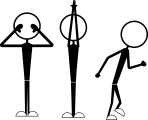 |
Are you fit enough to weave? Do your back, knees or ankles hurt after weaving for awhile? How about your neck? Oh, your hips hurt more than all the other hurts that you complain about! Do your hands ache after throwing the shuttle? How about your shoulders after using your fly shuttle all afternoon?
If any or all the aches and pains mentioned above affect you, maybe it’s time to get yourself into better physical shape. I’m not going to tell you that you should lose weight or go to the gym–those are personal decisions. Instead, I’m going to suggest some stretches and range of motion exercises that you can incorporate into your weaving time. Oh, and the first thing I’m going to suggest is you should- |
| Check Your Posture. | |
 |
Ideally, you should stand and walk with your spine straight, your shoulders back and down and your bum tucked in. The best way to check your posture is to place your back against the wall so that you spine touches it on its whole length. You may have to move your feet out from the wall to accomplish this. Next, raise your arms and hands over your head with your arms and back of your hands touching the wall. Bring your arms slowly down to your sides while they are still in contact with the wall. Step out from the wall–this is what your posture should look like. Your shoulders are back and down, your bottom is tucked in and your head and shoulders are directly over your hips. It may feel strange at first, but look in the mirror. You are not only on your way to perfect posture, you look taller, younger and five pounds lighter! |
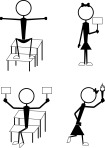 |
If you’re weaving for a long time, you should stop occasionally to check your posture. When most weavers weave, they tend to round their shoulders forward and slump toward the front of the loom. Checking your posture will help remind your body how it is supposed to be. Make sure your bench is at the right height, too. The ideal is to perch – not sit – on the bench. Your legs should be positioned so your feet can push down on the treadles easily and you don’t have to lift them far to change treadles. Your trunk should move forward and back from your hips and your arms should be at a comfortable height and angle for throwing and catching the shuttle.
The next suggestion I have is – |
| Take Frequent Breaks. | |
 |
Try to get up from the loom bench about once each hour. This is a good time to do stretching and/or range of motion (ROM) exercises. |
| —Stretch your neck by moving your head from side to side and gently rolling your head forward-to one side-back and to the other side. Look to your right and then your lefts and hold those positions for about 10 seconds. | |
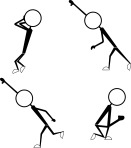 |
—Move your arms from the shoulder in a big circle and roll you shoulders, too. When your hands are behind your back, clasp them and push back. Hold it for at least 30 seconds. Repeat if you want. |
| —Do runners’ stretches. Grab on to the breast beam and lean forward. Put one foot back. Bend the forward knee and feel the stretch in the back of the thigh and calf. Hold it for at least 30 seconds and then switch legs. Do a few sets. | |
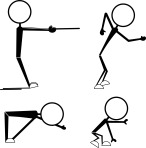 |
—Stretch your hip joints. Put your feet a little more than shoulder width apart. Bend one knee and lean toward that side. You should feel the opposite hip joint stretching. Change sides. Hold each side stretch about 30 seconds and do each side three or four times. |
| —Stretch out your back. Put your feet a comfortable distance apart. Lean over and put your hands on your lower thighs. Lean a little further and then roll yourself up one vertebra at a time. Do this two to three times. | |
| —How are your hands feeling? They could use a stretch, too. Put the tips of your fingers together and gently push to hyper-extend the fingers. Interlace the fingers and turn your hands palms outward and push to hyper-extend the wrists. Hold it and slowly raise the clasped hands over your head. | |
| Okay, Now you’re thinking that you’ll never get any weaving done with all these exercises. Well, my suggestion is that you do one of these every hour or so. Yes, I know that when you are weaving you tend to lose track of time. Connect your breaks/ exercises with natural stops. I listen to recorded books while I weave. Most of the CDs last about an hour. I get up, change the disk and do an exercise. Or, if you are doing pattern weaving, you could do the exercises after so many repeats. How about every time you have to get up to wind more bobbins? If all else fails, set a timer so you remember to do an exercise.
As we age, our bodies start to fail us so, even with exercise, we still might not be comfortable. Check with your doctor about taking aspirin and/ or tylenol for pain. Both are excellent medicines but both can cause major problem if you take too much of them. Heat is a marvelous comfort. Hot showers, hot Jacuzzis, even hot paraffin hand baths help. I like a heating pad at night –on whatever is bothering me. |
|
 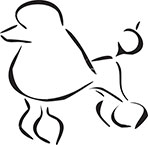 |
If you have a dog, take him for a walk once or twice each day. If you don’t have a dog, take a walk anyway. If you haven’t done any walking lately, start with 15 minutes and work up to about an hour. It is good all around exercise and will make you feel better.
If you have access to a pool, another good exercise and stress reliever is swimming. Sign up for a yoga or Pilates class. Both systems concentrate on strengthening your core and making you aware of your range of motion in your joints. The goal is to allow ourselves to continue weaving, spinning, felting, sewing, etc. in comfort for as long as we want. |
 |
|